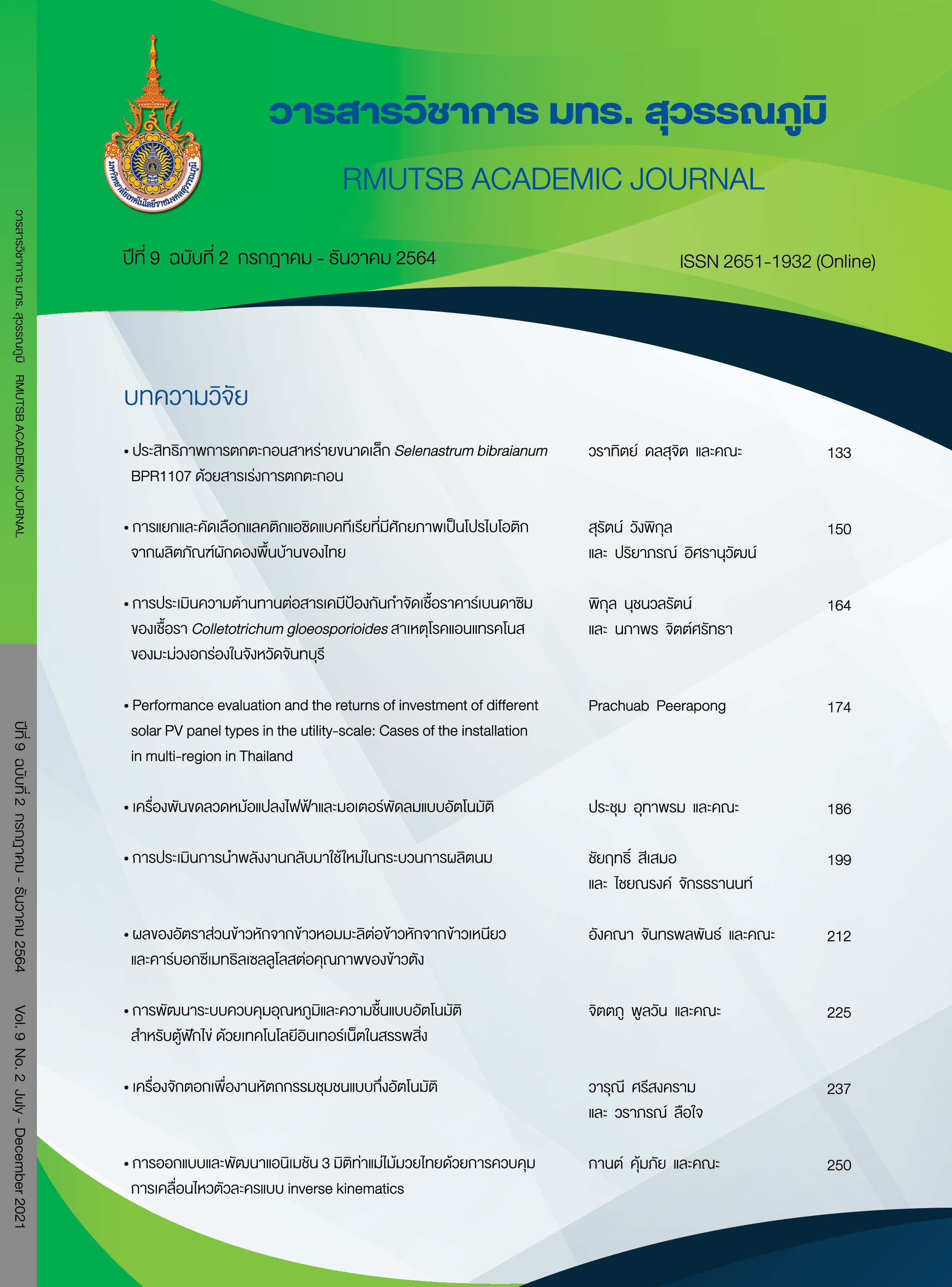Performance evaluation and the returns of investment of different solar PV panel types in the utility-scale: Cases of the installation in multi-region in Thailand
Main Article Content
Abstract
This research aimed to investigate the performance analysis and the returns of investment of solar PV installation of the selected power plants in the utility-scale of different Solar PV panel types in each region of Thailand. The performance results of the plant were also compared with the simulation values obtained from Solar-GIS software. The performance analysis included the final yield of each plant installation, an annual performance ratio (PR), and an annual electricity generation (MWh/annum). The economic viability of investment in solar PV installation was in comparison by using the usage of the net present value (NPV), internal rate of return (IRR), and payback period (PB). The PV system performance in this study varied from 71.1% to 84.50% and their energy yields per annum varied from 1,361 kWh/kWp to 1,467 kWh/kWp (poly c-Si); 1,492 kWh/kWp to 1,635 kWh/kWp (a-Si); 1,381 kWh/kWp to 1,495 kWh/kWp (CIS). The returns of investment namely: Equity %IRR is in the range of 9-11%, and the payback period is less than 10-11 years. The results from this research concluded that in the northern regions such as in Lampang province, polycrystalline technology of solar PV is preferable and recommended. While in other regions amorphous and polycrystalline solar PV technologies can be used. The solar PV installations can reduce emissions at a maximum rate of 773 tons of CO2 per year of 1 MW installation in amorphous solar PV installation in Lop Buri province.
Article Details
Published manuscript are the rights of their original owners and RMUTSB Academic Journal. The manuscript content belongs to the authors' idea, it is not the opinion of the journal's committee and not the responsibility of Rajamangala University of Technology Suvarnabhumi
References
EPPO. (2020). Thailand power development plan 2018-2037 (PDP 2018 revision 1). Bangkok: Energy Policy and Planning Office, Ministry of Energy.
Humada, A. M., Hojabri, M., Hamada, H. M., Samsuri, F. B., & Ahmed, M. N. (2016). Performance evaluation of two PV technologies (c-Si and CIS) for building integrated photovoltaic based on tropical condition: A case study in Malaysia. Energy and buildings, 119, 233-241.
Kumar, B. S., & Sudhakar, K. (2015). Performance evaluation of 10 MW grid connected solar photovoltaic power plant in India. Energy reports, 1, 184-192.
Ma, T., Yang, H., & Lu, L. (2013). Performance evaluation of a stand-alone photovoltaic system on an isolated island in Hong Kong. Applied Energy, 112, 663-672.
Mohammadi, K., Naderi, M., & Saghafifar, M. (2018). Economic feasibility of developing grid-connected photovoltaic plants in the southern coast of Iran. Energy, 156, 17-31.
Nour-eddine, I., Lahcen, B., Fahd, O. H., Amin, B., & Aziz, O. (2020). Outdoor performance analysis of different PV technologies under hot semi-arid climate. Energy Reports, 6, 36-48.
Perez, R., Ineichen, P., Moore, K., Kmiecik, M., Chain, C., George, R., & Vignola, F., (2002). A new operational model for satellite-derived irradiances: description and validation. Solar Energy, 73(5), 307-317.
Quansah, D. A., Adaramola, M. S., Appiah, G. K., & Edwin, I. A. (2017). Performance analysis of different grid-connected solar photovoltaic (PV) system technologies with combined capacity of 20 kW located in humid tropical climate. International Journal of Hydrogen Energy, 42(7), 4626-4635.
Shukla, A. K., Sudhakar, K., & Baredar, P. (2016). Simulation and performance analysis of 110 kWp grid-connected photovoltaic system for residential building in India: A comparative analysis of various PV technology. Energy Reports, 2, 82-88.
Skoczek, A., Sample, T., Dunlop, E. D., & Ossenbrink, H. A. (2008). Electrical performance results from physical stress testing of commercial PV modules to the IEC 61215 test sequence. Solar Energy Materials and Solar Cells, 92(12), 1593-1604.
Skoczek, A., Sample, T., & Dunlop, E. D. (2009). The results of performance measurements of field-aged crystalline silicon photovoltaic modules. Progress in Photovoltaics, 17(4), 227-240.
Solargis. (2021). pvplanner. Retrieved January 13, 2021, from http://www.solargis.info/pvplanner/


